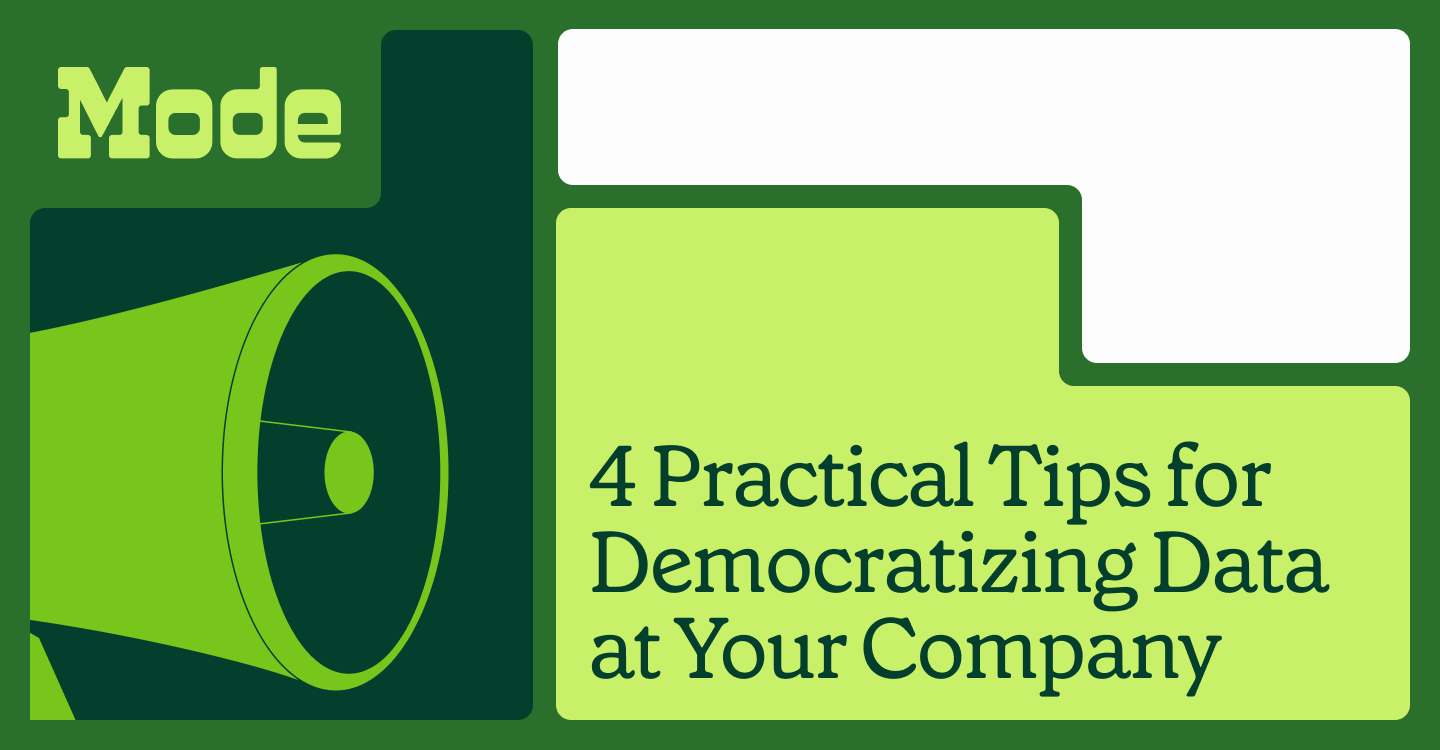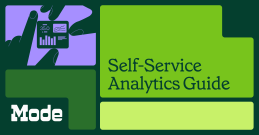4 Practical Tips for Democratizing Data at Your Company
Melissa Bierly, Content Marketing
August 11, 2016•Updated on June 14, 2023
NaN minute read

Over the past few months, we've heard a bunch of cool ideas for how analysts are distributing data across organizations. None of these techniques are silver bullets on their own, but together they create a powerful set of habits that democratize data.
Distribution channels for democratizing data
Opening up data to the company starts with the simple act of granting access, but the more important act is the follow-through: getting people to actually use data regularly. Great analytics teams champion data daily usage, making sure no one goes a day without seeing (or wanting to see) data that's relevant to them.

A Guide to Self-Serve Analytics
Self-service analytics is necessary—here's what makes the practice successful.
1. Give memorable data updates at all-hands meetings
All-hands meetings can be a great opportunity to get data in front of people. That said, you need to be very thoughtful about the presentation. Nothing makes people's eyes glaze over like slide after slide of charts with no explanation or context.
Tips:
People don't remember data; they remember stories. When you share the results of recent experiments or analyses, don't just put a chart on a slide. Your goal should be to educate people about how your company is using data to make decisions. Tell them a story that walks through the problem, how you tackled it (in human-speak, not jargon), and the conclusion you reached.
Establish core metrics. At Mode, we've decided on four key metrics tailored to our unique business that drive the whole company: growth, engagement, retention, and monetization. At our weekly meeting, we walk through what's changed and what hasn't through what's changed and what hasn't. Constant exposure to the same metrics familiarizes people with the data that matters most.
2. Send an internal data newsletter
We're willing to bet you don't have an all-hands meeting every day, so what do you do to expose people to data during the time in between? Email can be an effective channel for regularly showing the work your analytics team is doing.
For example, TuneIn's analytics team sends a weekly email to keep the company up-to-date with what they're working on. Their CEO also includes metrics in his weekly update, so that the numbers are put in context of what's happening company-wide.
When the Twitch Science team makes a huge discovery that will impact many parts of the business, they send out an email with a polished, well-written summary of the results.
What works for one company won't work for another, so try out different methods. A good first step is to ask other teams what data interests them and see where there's overlap.
Tips:
Leverage your CEO. If your CEO sends out regular company updates, ask her if certain metrics would help to provide additional context. Such an email can be a great signal to the company of just how much data matters.
Embed a chart or two in email summaries. From Matt Isanuk, Head of Analytics at Thumbtack: “People are more likely to click through to an underlying presentation if there's a visual sneak peek.”
Invest in written communication. Advice from Drew Harry, Director of Science at Twitch: “We've worked hard on writing concise but nuanced descriptions of what we've learned. We try to make sure we don't get too into the weeds, but we do express the scope of impact of what we've done.”
3. Embed dashboards into familiar tools
Every team has a domain-specific tool where they spend most of their time. These tools have dashboards of their own, but they often don't provide the capabilities for custom analyses—such as combining sales data with product data.
Rather than trying to push each team into a new tool to view a custom dashboard, embed their analyst-created dashboard in the tool they work in every day. It'll accomplish the same result (an informed workforce) without the friction of switching between tools.
Alex Miller, Sales Operations Manager at Zinc by Service Max, embeds dashboards in Salesforce. When the Zinc analytics team uncovered a leading indicator of companies looking to transition from a free plan to a paid plan, they embedded the information right into Salesforce.
The real beauty of this, according to Alex, is that “Sales reps didn't need to take any action to get access to this data. The underlying report runs as soon as the rep opens the account page, and the data is there, visible and actionable.”
4. Make time for one-on-one data consultation
Nothing beats face-to-face communication. Whether it's setting up office hours or simply being responsive to requests for meetings, strive to make yourself available as a consultant to your co-workers. Drew Harry, Director of Science at Twitch has great advice on what makes the consultation process successful:
“The consultation process is the heart of what a good data scientist does. They teach their customers how to ask good questions and how to interpret the results. They don’t just hand someone numbers.”
Tips:
Gauge expectations upfront. Ask questions like “What would be a good outcome for you?” and “What would you do if the results you get back aren't what you expected?” Sometimes people have their minds made up already, so it's important to know that you'll need a bunch of negative evidence to convince them otherwise.
Know when data analysis can't answer the question. Data science can't solve every problem. Sometimes questions will crop up and there won't be enough good data to support a decision one way or the other. In those cases, professional intuition might be the only way to arrive at a decision. Don't be afraid to say so.
Thanks to Miju Han, Matthew Isanuk, Drew Harry, and Alex Miller for sharing how they democratize data at their organizations.
Get our weekly data newsletter
Work-related distractions for data enthusiasts.




